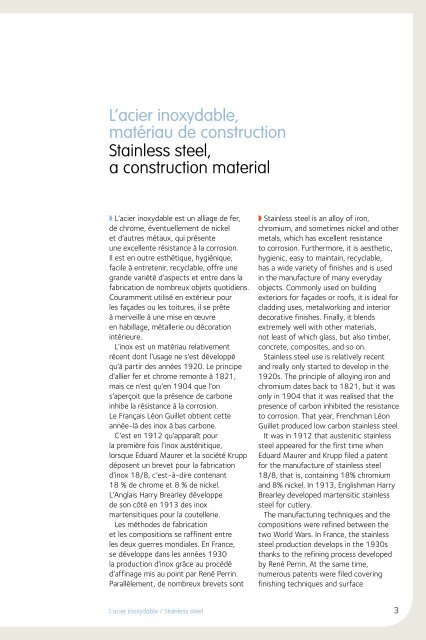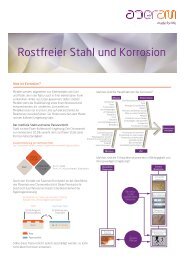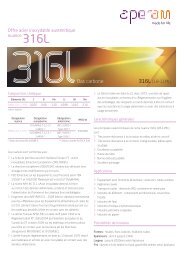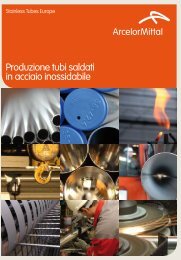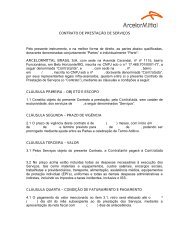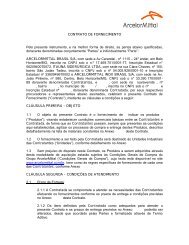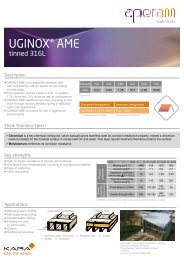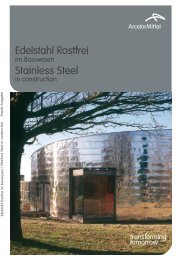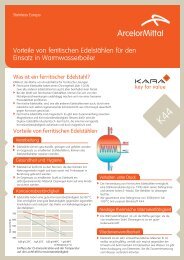Stainless Steel L'acier inoxydable - Aperam
Stainless Steel L'acier inoxydable - Aperam
Stainless Steel L'acier inoxydable - Aperam
You also want an ePaper? Increase the reach of your titles
YUMPU automatically turns print PDFs into web optimized ePapers that Google loves.
L’acier <strong>inoxydable</strong>,<br />
matériau de construction<br />
<strong>Stainless</strong> steel,<br />
a construction material<br />
◗ L’acier <strong>inoxydable</strong> est un alliage de fer,<br />
de chrome, éventuellement de nickel<br />
et d’autres métaux, qui présente<br />
une excellente résistance à la corrosion.<br />
Il est en outre esthétique, hygiénique,<br />
facile à entretenir, recyclable, offre une<br />
grande variété d’aspects et entre dans la<br />
fabrication de nombreux objets quotidiens.<br />
Couramment utilisé en extérieur pour<br />
les façades ou les toitures, il se prête<br />
à merveille à une mise en œuvre<br />
en habillage, métallerie ou décoration<br />
intérieure.<br />
L’inox est un matériau relativement<br />
récent dont l’usage ne s’est développé<br />
qu’à partir des années 1920. Le principe<br />
d’allier fer et chrome remonte à 1821,<br />
mais ce n’est qu’en 1904 que l’on<br />
s’aperçoit que la présence de carbone<br />
inhibe la résistance à la corrosion.<br />
Le Français Léon Guillet obtient cette<br />
année-là des inox à bas carbone.<br />
C’est en 1912 qu’apparaît pour<br />
la première fois l’inox austénitique,<br />
lorsque Eduard Maurer et la société Krupp<br />
déposent un brevet pour la fabrication<br />
d’inox 18/8, c’est-à-dire contenant<br />
18 % de chrome et 8 % de nickel.<br />
L’Anglais Harry Brearley développe<br />
de son côté en 1913 des inox<br />
martensitiques pour la coutellerie.<br />
Les méthodes de fabrication<br />
et les compositions se raffinent entre<br />
les deux guerres mondiales. En France,<br />
se développe dans les années 1930<br />
la production d’inox grâce au procédé<br />
d’affinage mis au point par René Perrin.<br />
Parallèlement, de nombreux brevets sont<br />
◗ <strong>Stainless</strong> steel is an alloy of iron,<br />
chromium, and sometimes nickel and other<br />
metals, which has excellent resistance<br />
to corrosion. Furthermore, it is aesthetic,<br />
hygienic, easy to maintain, recyclable,<br />
has a wide variety of finishes and is used<br />
in the manufacture of many everyday<br />
objects. Commonly used on building<br />
exteriors for façades or roofs, it is ideal for<br />
cladding uses, metalworking and interior<br />
decorative finishes. Finally, it blends<br />
extremely well with other materials,<br />
not least of which glass, but also timber,<br />
concrete, composites, and so on.<br />
<strong>Stainless</strong> steel use is relatively recent<br />
and really only started to develop in the<br />
1920s. The principle of alloying iron and<br />
chromium dates back to 1821, but it was<br />
only in 1904 that it was realised that the<br />
presence of carbon inhibited the resistance<br />
to corrosion. That year, Frenchman Léon<br />
Guillet produced low carbon stainless steel.<br />
It was in 1912 that austenitic stainless<br />
steel appeared for the first time when<br />
Eduard Maurer and Krupp filed a patent<br />
for the manufacture of stainless steel<br />
18/8, that is, containing 18% chromium<br />
and 8% nickel. In 1913, Englishman Harry<br />
Brearley developed martensitic stainless<br />
steel for cutlery.<br />
The manufacturing techniques and the<br />
compositions were refined between the<br />
two World Wars. In France, the stainless<br />
steel production develops in the 1930s<br />
thanks to the refining process developed<br />
by René Perrin. At the same time,<br />
numerous patents were filed covering<br />
finishing techniques and surface<br />
L’acier <strong>inoxydable</strong> / <strong>Stainless</strong> steel 3


